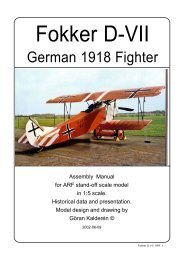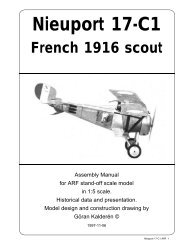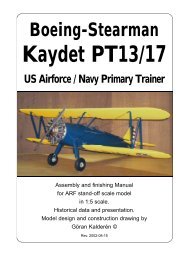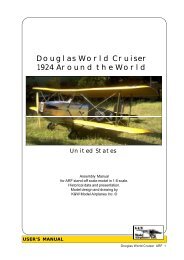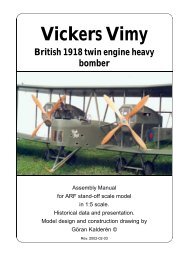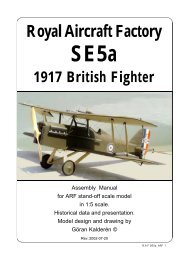Download PDF Manual - Macca's Vintage Aerodrome
Download PDF Manual - Macca's Vintage Aerodrome
Download PDF Manual - Macca's Vintage Aerodrome
- No tags were found...
Create successful ePaper yourself
Turn your PDF publications into a flip-book with our unique Google optimized e-Paper software.
Sk1 CFV Albatros 120Produced early in 1914, the Albatros B-II wasa development of the highly successful pre-war twoseaterdesigned by Ernst Heinkel. For its day it wasa powerful aeroplane and this fact, allied to its wellproportioned rugged construction, admirably suitedit for its General Duties classification.In July 1914 a sales representative/companypilot toured Northern Europe and after a visit inCopenhagen, Denmark the tour aimed forStockholm, Sweden. Upon landing on a military trainingfield in the northern part of Stockholm, disasterstruck and the aircraft overturned, breaking the propellerand damaging the fin and rudder. Replacementparts were ordered from Berlin but when theyarrived in Sweden, the propeller did not fit. A localairplane manufacturer helped to make the necessaryadjustments but in the meantime the war brokeout in Germany and the crew was telegraphicallyordered to return to Berlin, leaving the aircraft behind.Although quite orthodox in appearance theAlbatros BII did have one or two unique features.The wings, however, were a fairly normal two-baystructure built up on two wooden main spars, theforward spar being in very close proximity to the leading-edgeand the rear spar at midchord. This resultedin an extremely flexible trailing-edge which addedconsiderably to lateral stability. Ribs were of spruceply and the whole wing structure fabric covered; thetrailing-edge was of wire which resulted in the distinctivescalloped appearance associated with somany German aircraft. Ailerons were of steel tubeconstruction, of inverse taper, and operated viacables through the lower wing. The centre-sectioncut-out was of vee-shape with slightly curved sidesand extended forward to the rear spar. Bothinterplane, and centre-section trestle struts, were ofstreamlined steel tube and braced with strandedcable. Stagger and sweep were both nil, dihedral wasin the nature of 4 deg. and incidence 4.8 deg.One of the unique features of this machinewas the plywood covered fuselage. Built on a foundationof six longerons (two ash and four spruce)and sturdy ply formers, no internal wire bracing wasneeded and an extremely rugged structure resulted.Apart from a slightly rounded decking aft of the rearcockpit the fuselage was quite ‘slab sided’ and taperedto a vertical knife-edge at the rear The extremelyangular tail surfaces were of considerablearea and made for great stability. All the fixed surfaceswere of triangular profile while the outline ofthe control surfaces was approximately trapezoidal.The fabric covers empennage was completely constructedof steel tube and of ‘flat plate’ section. Pilot’scontrols consisted of normal rudder-bar and a wheeltype control column for aileron and elevator control.Throttle was conveniently situated to the left handand in the event of any failure in the linkage to theengine, the motor automatically went to full throttleand did not stop as was the arrangement on Alliedtypes. Instruments fitted included revolution counter,altimeter, fuel pressure gauges, fuel pressure pump,magneto switches, temperature gauge, etc. Air speedindicators were not usually fitted in the cockpits ofany German aircraft; but when carried they were ofthe anemometer type, and clamped to a strut easilyvisible to the pilot. A compass was usually slung inthe apex of the centre-section trestle or in the lowerwing root.There was nothing exceptional about the undercarriagewhich was of normal steel tube vee-type,the axle being sprung with elastic cord. The ash tailskid was likewise sprung with this cord.The radiator was mounted on the leading edge ofthe top wing and it had louvres adjustable from thecockpit, to regulate the amount of cooling air needed.The original aircraft was copied at to a certainextent, improved. It was manufactured by severalaircraft manufacturer in Sweden including themilitary factory in Linköping. Several of these airplanesserved on and when the Swedish Airforcewas formed in 1926, they were transferred and renamedSk1 and Ö1 depending on the powerplantinstalled.Sk1 Albatros ARF 2Sk1 Albatros 120 in the Swedish Airforce Museum



